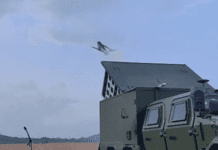This post is also available in:
 עברית (Hebrew)
עברית (Hebrew)

Laser weapons, once the stuff of science fiction, are becoming practical – bringing militaries the ability to defend against attacks without having to make, transport or store munitions. The shots are cheap – as little as a dollar each – and the ammunition never runs out as long as there is electrical power.
“We’re at the tipping point where, no kidding, we can take this from aspirational – from lab models – to something we can field and use.” This, according to Rick Hunt, vice president for Navy/Marine Operations at Raytheon in an interview to defense-update. “People are hitting the ‘I Believe’ button.” In 2010, the company demonstrated a laser weapon that shot four target drones out of the sky.
Raytheon is one of several defense contractors chosen by the Office of Naval Research to develop a high-powered laser weapon capable of hitting fast-moving targets at a distance. Raytheon has already produced more than 50,000 lower-power military lasers, including sights and targeting equipment, and currently makes a wide array of laser-guided munitions, including artillery shells, bombs and rockets.
In 2014, the Navy demonstrated the flexibility of laser weapons with a series of tests aboard a USS vessel operating in the Persian Gulf. Operators used a videogame-style controller to blast moving targets at sea, including some mounted on a speeding small boat, and in the air. The laser pinpointed the targets with radar data from a Raytheon Phalanx ship defense system.
 Register to iHLS Israel Homeland Security
Register to iHLS Israel Homeland Security
 “We ran this particular weapon, a prototype, through some extremely tough paces, and it locked on and destroyed the targets we designated with near-instantaneous lethality,” Rear Adm. Matthew L. Klunder told Navylive. Laser weapons are affordable, added Adm. Klunder, costing about a dollar a shot. They are also well-suited to warships, which can serve as stable weapons platforms with room for power generation and cooling. Vessels like the new USS Zumwalt destroyer have a surplus of electrical power that commanders could use for powerful lasers of the future, the Navy has said.
“We ran this particular weapon, a prototype, through some extremely tough paces, and it locked on and destroyed the targets we designated with near-instantaneous lethality,” Rear Adm. Matthew L. Klunder told Navylive. Laser weapons are affordable, added Adm. Klunder, costing about a dollar a shot. They are also well-suited to warships, which can serve as stable weapons platforms with room for power generation and cooling. Vessels like the new USS Zumwalt destroyer have a surplus of electrical power that commanders could use for powerful lasers of the future, the Navy has said.
Lasers are not limited to the sea. The mobile laser subsystem Raytheon is developing for the Marines would use the company’s proprietary design, known as planar waveguide technology. A single planar waveguide device the size and shape of a 12-inch ruler can generate sufficient power to disable small aircraft.
“What we’re working on will be smaller than an office desk; easily fits on a ship, could fit on a Humvee,” said Raytheon’s Hunt. “You can start to think about putting this on a good-sized airplane. Wow! It opens doors we did not think were open before.” According to Hunt, laser weapons promise to give the United States and its allies a critical advantage on the battlefield. “It’s going to be us or it’s going to be the bad guys,” he said. “We’ve got to get it out first.”
























